Looking for a life-long pet reptile? Then look no further than a ball python! This snake is perfect for first-time owners as well as being great for enthusiasts looking to add to their collection.
These popular snakes are hardy, easy-going, and live for between 20 to 30 years in captivity. They live off a 100% rodent diet and have no special housing or lighting requirements (apart from a correctly sized cage)!
Ball pythons are non-venomous, easy to handle, and come in a variety of morphs; so there is a color for every personality. Continue reading to learn more about their diet, housing, tank requirements, and the best places to buy one from.
Is A Ball Python A Good Pet?

Ball pythons are popular pets due to their friendly nature, incredibly long lifespan and variety of appearances and colors.
Native to the grasslands of West and Central Africa, ball pythons are carnivores of small mammals, and in the wild, their diet includes shrews, rodents, and birds. They are nonvenomous, as they strike before constricting their prey, killing without the need for venom.
Due to their popularity, this snake can easily be found, however, great care should be taken to ensure you aren’t supporting an illegal pet trade and only purchase captive-bred snakes. Pet Ball Pythons are easy to feed, have a docile temperament towards humans, and are generally in great health.
Their name comes for a certain behavior they exhibit when startled or stressed, during times of stress, they curl inwards making their body into a ball-shape!
| Summary Table | |
|---|---|
| Common Names | Ball or Royal Python |
| Scientific Name | Python regius |
| Adult Size | Females between three to five feet and Males two to three feet |
| Adult Weight | 2-4 pounds |
| Lifespan | 20 to 30 years |
| Diet | Mice & Rats (Pinky, Small and Medium) |
| Tank Size | Plastic, 30-40 gallon vivarium |
| Temperature | Humidity between 50- 60% Temperatures between 88-92°F (daytime) and 82-83°F (night-time) |
| Popular Alternatives | Corn snake, Boa constrictor |
Ball Python Care Sheet
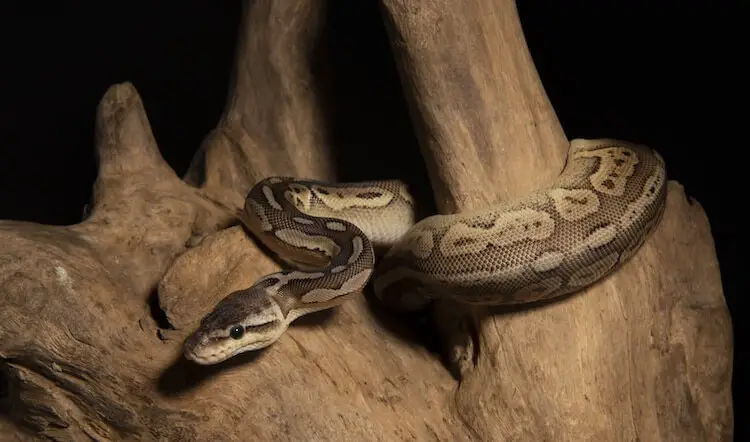
Ball pythons are native to West and Central Africa where they typically reside in grasslands and shrublands.
Like other snakes, when not hunting for prey, these guys love to spend time in hidey-holes close to the ground. In the wild, it has been noted that males occasionally venture vertically into trees, while females tend to remain at ground level.
In captivity, ball pythons are low maintenance and don’t have any special dietary requirements.
Housing Requirements
Plastic vivariums (with a covered top, bottom and sides) are favored for pythons because of the privacy it affords them and security it provides them with. A plastic cage will also makes it ideal for maintaining correct temperatures and humidity levels with a secure top deterring any budding escape artists!
The size of the cage will be based on the size of your reptile:
- You should start off with a 10 gallon container for your hatchlings, anything much larger will cause stress
- Juveniles can be housed in 20 gallon enclosures
- An adult ball python should have a 30-40 gallon enclosure
Decorate the enclosure with other fake fauna, rocks and places to hide to encourage exploration:
- Hatchlings should have at least one hide box and some fake fauna & rocks in their enclosure
- Include at least two hide boxes (half logs or cork bark tubes work great) for your adult ball pythons, one on the cool side and the other on the warmer side of the enclosure
Heating and Lighting
Ball pythons do not require any special-lighting (e.g. UVB) in their tank, however normal day-night cycles should be mimicked as well as possible.
Do not place the enclosure directly next to a window, you cannot control the intensity or duration of the sun’s rays! A basking-bulb can be provided. However, it should only heat a small area, large enough for your snake to coil under.
Like most pet snakes, Ball pythons need supplemental heating in their enclosure.
Many shop-purchased plastic enclosures for snakes may already come with heating tape on the bottom. Heating tape or a heating mat is ideal as it heats from the snake’s underbelly and can be installed to heat a specific area of the tank.
Aim to only heat one third of your snake’s enclosure.
Providing both a cooler and warmer side in their tank is essential as it gives your ball python a choice and better replicates their natural environment.
| Heating Guidance* | |
|---|---|
| Ambient | around 82°F |
| Cooler-Side | 76-80°F |
| Warmer-Side | 88-92°F |
*Do not exceed 95°F or drop below 75°F, this can be harmful to your snake.
Substrate
The ball python, in general, thrives in a warm, humid environment. The best substrates for retaining moisture can help you in maintaining optimal humidity levels inside the enclosure.
A substrate such as cypress mulch is the best choice for your ball snake. Cypress mulch will help to retain moisture, is relatively inexpensive and allows your snake to burrow slightly!
Its cheap price-tag makes it easy to spot clean and replace during monthly deep-cleans.
| Tank Tips | |
|---|---|
| Tank Type | Plastic vivarium – 30-40 gallon for adults |
| Lighting | No special lighting |
| Heating | Heating tape |
| Best Substrate | Cypress mulch |
What Should You Feed A Ball Python?
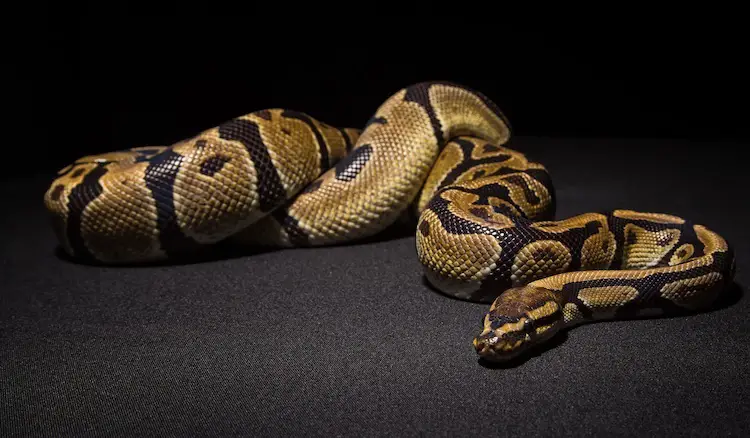
In their native habitat, the ball python’s diet consist of small mammals (e.g. shrews, rats) and birds. They strike to catch their prey with their mouths and then quickly coil around and constrict them.
It is recommended to feed your python rats as they range in size and medium-sized rats are sufficient for an adult. Mice can be used during the hatchling phase, but beginners should be aware that transitioning your snake from mice to rats can sometimes be difficult.
Do not feed your snake live prey as the prey will try to defend themselves and can harm your snake.
Frozen mice and rats can be purchased from commercial providers and should be thawed warmed to room-temperature before feeding:
- Hatchlings should be fed one crawler mouse or one pinky rat or mouse every 5 days
- At the juvenile stage, your snake should transition to pinky or fuzzy rats, which can be fed every 7 days
- Adults should be fed a medium-sized rat every 7-10 days. As your ball python grows, increase the prey size and amount as necessary
Most captive ball pythons are fed with frozen-thawed rodents from the time they hatch and are usually acclimated to this type of meal. Use tongs or a gloved hand to entice your snake to ‘catch’ their prey.
| Diet Summary | |
|---|---|
| Fruits | 0% of diet |
| Insects | 0% of diet |
| Meat | 100% of diet – small or medium sized rats |
| Supplements Required | N/A |
Common Health Issues
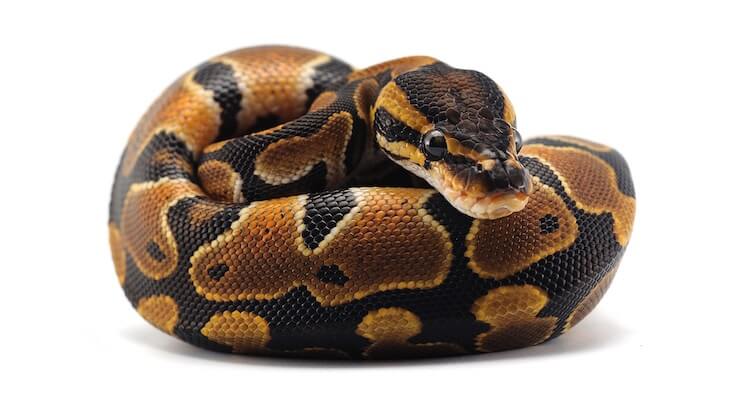
Most diseases and health problems can be avoided by taking proper care of your snake through appropriate feeding, correct enclosure-size, suitable temperature & humidity, and reducing stress. Ball pythons are hardy snakes and aren’t predisposed to many serious health problems.
Some common problems to look out for are incomplete shedding, mites, and respiratory infections.
Incomplete shedding can happen to any snake and can be easily prevented if you provide adequate humidity in their enclosure. The most likely time for this to occur is when your snake is adjusting to his new enclosure. Commonly, incomplete shedding will leave ‘caps’ of shed over your ball pythons’ eyes. If you notice this, you can bathe your python in lukewarm water for 15-20 minutes.
It is important, before purchasing, to make sure your ball python is free of mites as they are tricky to eradicate. Mites look like small black specks on light-colored scales and will be harder to spot on darker parts of your snake. Getting rid of a mite problem can be tedious and time consuming, especially for novice owners.
A respiratory infection is another health problem that can occur in Boas. This can be caused by improper temperature regulation in your snake’s enclosure. If you notice your snake isn’t eating, they are less active than normal or saliva or bubbles around their mouth and/or nose, this could be a sign. You should consult a veterinarian for immediate treatment.
How Long Do Ball Python Live?
Captive pythons have an impressive lifespan of between 20 to 30 years. Providing proper veterinary care, husbandry and diet is essential to a long, happy life! Healthy ball python excrement consists of solid brown feces with a white urate cap and a small amount of urine.
In the wild, due to factors such as disease, predation, environmental factors, and competition, their lifespan is much shorter at around 10 to 15 years.
Tank Cleaning
Spot clean your snake’s enclosure daily, removing any soiled or wet substrate to prevent mold, foul smells and unwanted bacteria.
Deep clean the enclosure every one to two months by removing all items and cleaning them as well as the enclosure itself. You should also replace all of the substrate during each deep clean too.
Misting your ball python, or its enclosure daily, is typically not required, however, this may be necessary when your snake is shedding or if humidity levels are lower than optimal.
| Signs They Are Healthy | Sickness Symptoms |
|---|---|
| Clear eyes and bright coloring | Loss of appetite for an extended period |
| Regularly exploring and moving throughout their enclosure | Excessive hiding |
| Tongue flicking | Lethargy |
| Strike and constrict prey | Incomplete shedding |
Is A Ball Python Dangerous?
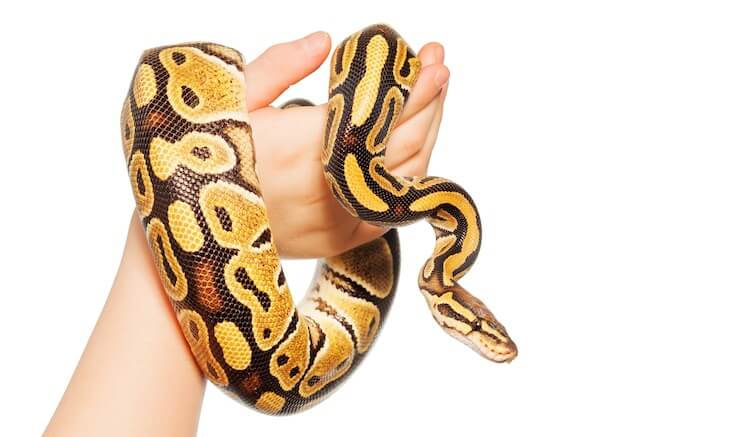
No. Ball pythons are docile and will spend most of their time stationary in their enclosure. You will normally see them hiding in a box.
Solitary reptiles and, apart from breeding, they spend most of their life alone.
Wild ball pythons have a coloration of browns and yellows which helps them blend into their natural habitat. They hunt by burrowing in a hiding spot (e.g. a below a tree stump or in a small mammal’s home) where they wait until striking and constricting their prey.
You should never house two or more ball pythons together. The only time this would be permitted is if it is a breeding pair, but special care and caution must be taken even in situations like these.
Snakes like to explore and sense their environment by using their tongue. A common defense mechanism, as well as where they get their name from, is to coil into a ball with their head in the middle.
Handling Advice
Start by washing your hands with soap and water before and after handling; this prevents the spread of possible diseases.
Handling is easier than beginner’s might think. Most importantly, you should avoid startling your snake:
- Start by gently touching your ball pythons back while they are safe in their enclosure
- Now that your snake knows your there, reach under the mid-body of your snake and, while supporting most of its body weight, confidently and deliberately lift them into your arms
- Allow your snake to coil around your arms and body and explore
Never tightly grasp your snake as this may cause them to be defensive. Ball pythons will not bite unless provoked and are non-venomous. Biting, hissing, and perching upwards are your snake’s way of trying to communicate, “I don’t like that/I am uncomfortable”. Avoid touching or disturbing your snake if it displays defensive behaviors.
After adopting your reptile, allow 1-2 weeks for them to adjust to their new environment before handling.
When you are both ready, start with short sessions a couple of times each week, these can last 5-10 minutes. As your snake grows and gets more comfortable, you can lengthen these sessions to 30 minutes. Handling as a routine will help to maintain tameness.
Handling Tips
- Ball pythons are usually easier to handle during the day when they are not as alert or active
- Avoid handling during the shedding period
- Wait at least 24 hours after feeding before handling your snake to reduce the chance of regurgitation
Appearance Of Ball Pythons
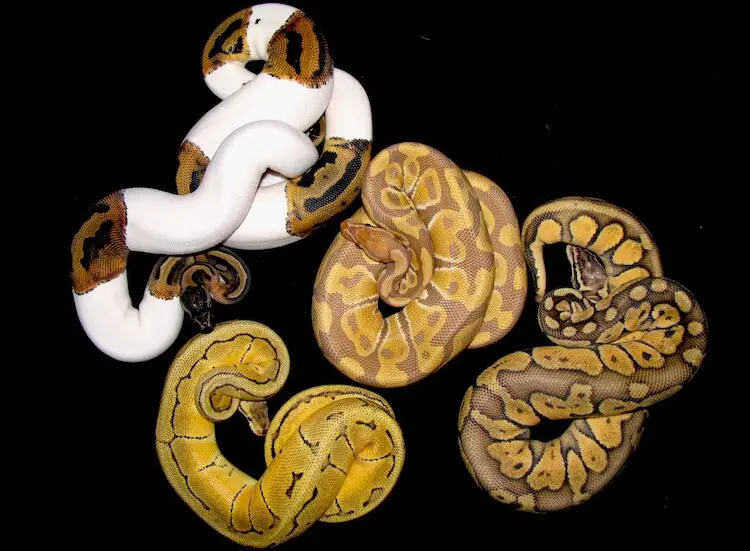
A full-bodied snake, with a pointed snout, females are always bigger than males. Both sexes are medium-sized snakes and come in a variety of colors with some variation in markings.
There are 30 primary recognized morphs, and while most may look similar to the untrained eye, there are a few with distinct differences.
Normal balls have shades of brown, black, and yellow, but morphs, such as the blue-eyed leucistic and ivory, have no markings present and are one solid color.
Some of the most common morphs are pastel, spider, mojave, pied ball, and pinstripe.
How Big Do Ball Pythons Get?
This snake is the smallest python species in Africa. Females will grow to an average length of 3-5 feet, and males only grow to a length of 2-3 feet. In this species, females are bigger than their male counterparts, with some research suggesting different diets being the cause.
While the upper average length of female ball snakes is 5 feet, many snakes do not reach this length. In captivity, ball pythons generally reach their full-grown size at three years old. Expect your adult python to weigh between two to four pounds, depending on size and sex.
Ball Python Buying Guide
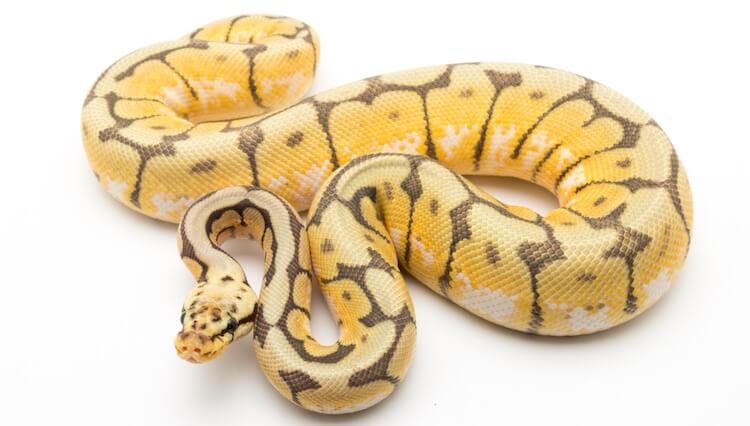
Whilst very common in the reptile trade, you should make sure that you trust the breeder (or supplier) before purchasing. Speak with the breeder and ask: what do you feed them, how many meals has this snake received, how old are they, etc. The breeder should be able to answer these questions with no problem.
You should be looking for a full-bodied snake with clear eyes, tongue flicking, and normal movement.
How Much Does A Ball Python Cost??
Due to the variety of Ball Python morphs, the price can vary largely from standards costing $40-$60 USD to specialized morphs such as the sunset, stranger, and monsoons costing over $1000 USD.
While most snakes are purchased as babies, other characteristics such as age, breeding status, and size, all factor into the price-tag. As captive breeding is ever-evolving, ‘rarer’ morphs become more common and new morphs are bred.
Young Ball Pythons
Babies hatch from eggs and are usually around 10 inches in length. Hatchlings will shed more frequently the younger they are and should shed for the first time within the first 14 days of hatching. It is normal for hatchlings to not eat for the first 7-10 days.
Males court females by pressing their belly on the female, where the male’s tail is wrapped underneath the females. Only put snakes together to breed, in the wild this is also the only time ball pythons are not solitary.
Ball pythons lay one clutch per season and on average, there are six eggs per clutch. Once laid, the eggs will take 6-8 weeks to hatch.
Care Guide Summary
| Why We Love Them | What Makes Them Difficult |
|---|---|
| Calm temperament | Should be housed individually |
| Easy to feed | Long lifespan of 20-30 years |
| Variety of colors | Usually sedatory |
There are many reasons for why ball pythons are one of the most popular species of snake in captivity. Their low maintenance and docile nature make them perfect for many herpers.
However, if you are looking for something a little different, consider a more active snake like the corn snake who love to explore and move around more in their enclosure.
If the Ball Python is too small for you, you can also look at a boa constrictor! While similar in temperament, boas are considerably bigger than pythons, so make sure you have done your research.
Keep in mind that while low maintenance, ball snakes have a long lifespan, so be prepared to have one around for a long time. Make sure that your home allows the space for an enclosure and that you can provide the right diet, environment, and care for your pet.

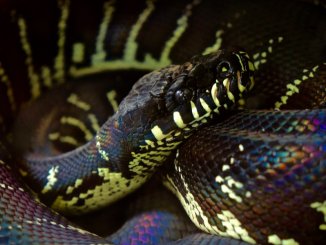
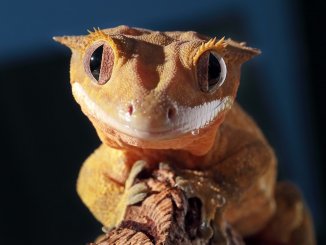
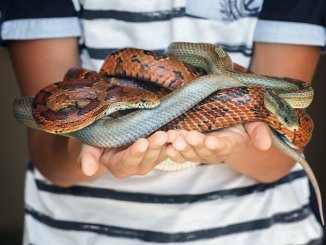

ME WANT A SUPER-SNEK
im getting a ball python for my birthday and i was doing some research before i get it. this helped me a lot on how I should feed it and give it time to adapt to me and it’s new surroundings.
Glad we could help!